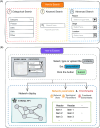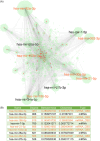CBD2: A functional biomarker database for colorectal cancer
- PMID: 38868513
- PMCID: PMC10989088
- DOI: 10.1002/imt2.155
CBD2: A functional biomarker database for colorectal cancer
Abstract
The rapidly evolving landscape of biomarkers for colorectal cancer (CRC) necessitates an integrative, updated repository. In response, we constructed the Colorectal Cancer Biomarker Database (CBD), which collected and displayed the curated biomedicine information for 870 CRC biomarkers in the previous study. Building on CBD, we have now developed CBD2, which includes information on 1569 newly reported biomarkers derived from different biological sources (DNA, RNA, protein, and others) and clinical applications (diagnosis, treatment, and prognosis). CBD2 also incorporates information on nonbiomarkers that have been identified as unsuitable for use as biomarkers in CRC. A key new feature of CBD2 is its network analysis function, by which users can investigate the visible and topological network between biomarkers and identify their relevant pathways. CBD2 also allows users to query a series of chemicals, drug combinations, or multiple targets, to enable multidrug, multitarget, multipathway analyses, toward facilitating the design of polypharmacological treatments for CRC. CBD2 is freely available at http://www.eyeseeworld.com/cbd.
Keywords: biomarker; colorectal cancer; database; network analysis.
© 2023 The Authors. iMeta published by John Wiley & Sons Australia, Ltd on behalf of iMeta Science.
Conflict of interest statement
The authors declare no conflict of interest.
Figures




References
-
- Granados‐Romero, Juan José , Valderrama‐Treviño Alan Isaac, Contreras‐Flores Ericka Hazzel, Barrera‐Mera Baltazar, Herrera Enríquez Miguel, Uriarte‐Ruíz Karen, Ceballos‐Villalba Jesús Carlos, et al. 2017. “Colorectal Cancer: A Review.” International Journal of Research in Medical Sciences 5: 4667–4676. 10.18203/2320-6012.IJRMS20174914 - DOI
-
- Tamborero, David , Rubio‐Perez Carlota, Deu‐Pons Jordi, Schroeder Michael P., Vivancos Ana, Rovira Ana, Tusquets Ignasi, et al. 2018. “Cancer Genome Interpreter Annotates the Biological and Clinical Relevance of Tumor Alterations.” Genome Medicine 10: 25. 10.1186/s13073-018-0531-8 - DOI - PMC - PubMed
LinkOut - more resources
Full Text Sources
